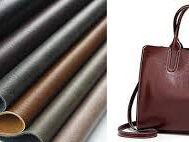Handbags come in a dazzling variety of styles—but have you ever wondered what they’re actually made of? The material used to manufacture a handbag plays a crucial role in its appearance, durability, functionality, and price.
Whether you're shopping for luxury designer bags or eco-friendly totes, understanding different handbag materials can help you make smarter and more sustainable choices.
In this blog, we break down the most common materials used in handbags, along with their pros, cons, and best-use scenarios.
1. Genuine Leather
Best for: Luxury, durability, long-term use
Features: Natural material, soft texture, high-end appeal
Genuine leather is one of the most popular and premium materials used in handbag manufacturing. It ages beautifully, becomes more supple over time, and can last for years with proper care.
Pros: Durable, classic look, ages well
Cons: Expensive, not vegan-friendly, requires maintenance
Popular keywords: leather handbag, luxury leather purse, real leather tote
2. Faux Leather (PU Leather or Vegan Leather)
Best for: Affordable fashion, cruelty-free shoppers
Features: Man-made, mimics leather’s look and feel
Faux leather—also called PU leather or vegan leather—is a synthetic alternative to real leather. It’s more affordable, animal-friendly, and comes in a variety of textures and finishes.
Pros: Budget-friendly, easy to clean, cruelty-free
Cons: Less durable, may peel or crack over time
Popular keywords: vegan leather handbag, faux leather purse, animal-free bag
3. Canvas
Best for: Casual, everyday use, eco-conscious shoppers
Features: Woven fabric, often made from cotton or linen
Canvas handbags are lightweight, durable, and often used for tote bags and casual styles. They’re easy to customize with prints and patterns and are popular in sustainable fashion circles.
Pros: Durable, washable, eco-friendly options available
Cons: Not water-resistant, may stain easily
Popular keywords: canvas tote bag, eco-friendly handbag, printed canvas purse
4. Nylon
Best for: Travel, sporty styles, all-weather use
Features: Synthetic fabric, water-resistant, lightweight
Nylon bags are ideal for those who need a lightweight, durable, and functional option. Commonly used in backpacks and sporty handbags, nylon is known for its resistance to water and wear.
Pros: Lightweight, water-resistant, low maintenance
Cons: Not as stylish or luxurious as leather
Popular keywords: nylon travel bag, waterproof handbag, sporty purse
5. Polyester
Best for: Budget fashion, functional designs
Features: Synthetic, durable, resistant to wrinkles and shrinking
Polyester handbags are similar to nylon but often used in lower-cost fashion bags. They are tough and resistant to the elements, making them suitable for daily use.
Pros: Affordable, strong, retains color well
Cons: Can feel less premium, not biodegradable
Popular keywords: polyester handbag, budget tote bag, everyday purse
6. Suede
Best for: Fashion-forward, fall and winter styles
Features: Soft, brushed texture, a type of leather
Suede is a luxurious leather variant known for its soft, velvety texture. While beautiful, it’s more delicate and requires extra care to avoid stains and water damage.
Pros: Stylish, soft texture, high fashion appeal
Cons: Prone to stains, not water-resistant, harder to maintain
Popular keywords: suede handbag, soft leather bag, fall fashion purse
7. Cork
Best for: Eco-conscious fashion, lightweight use
Features: Natural material, water-resistant, sustainable
Cork handbags are rising in popularity as a sustainable and vegan alternative to leather. They are lightweight, flexible, and naturally water-resistant.
Pros: Eco-friendly, lightweight, hypoallergenic
Cons: Limited availability, can be more expensive than faux leather
Popular keywords: cork purse, sustainable handbag, vegan cork bag
8. Jute
Best for: Summer bags, beach totes, eco-friendly lines
Features: Natural fiber, coarse texture
Jute handbags are perfect for summer and vacation wear. Often used in beach bags, jute is biodegradable and has a rustic, natural look.
Pros: Sustainable, lightweight, stylish for warm weather
Cons: Coarse feel, less durable over time
Popular keywords: jute tote bag, eco beach bag, summer handbag
9. Denim
Best for: Casual, trendy, everyday styles
Features: Durable cotton fabric, classic blue tones
Denim handbags offer a fun, youthful vibe. They pair well with casual outfits and are often upcycled from jeans for a sustainable twist.
Pros: Durable, trendy, casual appeal
Cons: Less formal, can fade with washing
Popular keywords: denim handbag, casual tote, recycled denim bag
Final Thoughts
When shopping for your next handbag, don’t just look at the style—consider the material. Whether you want something sustainable, stylish, or super durable, the right material can make all the difference.
From luxurious leather to eco-friendly cork, there's a handbag material for every budget, lifestyle, and fashion preference.
